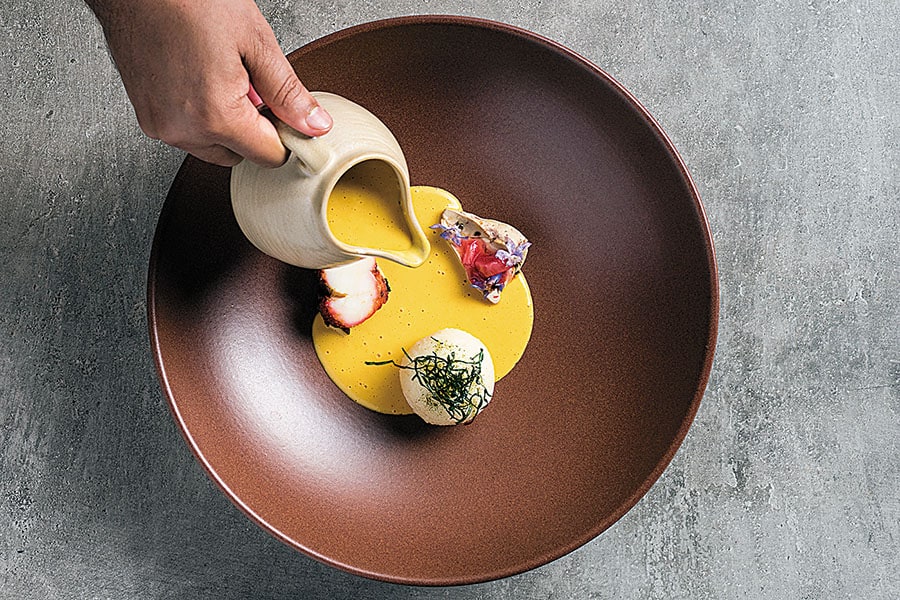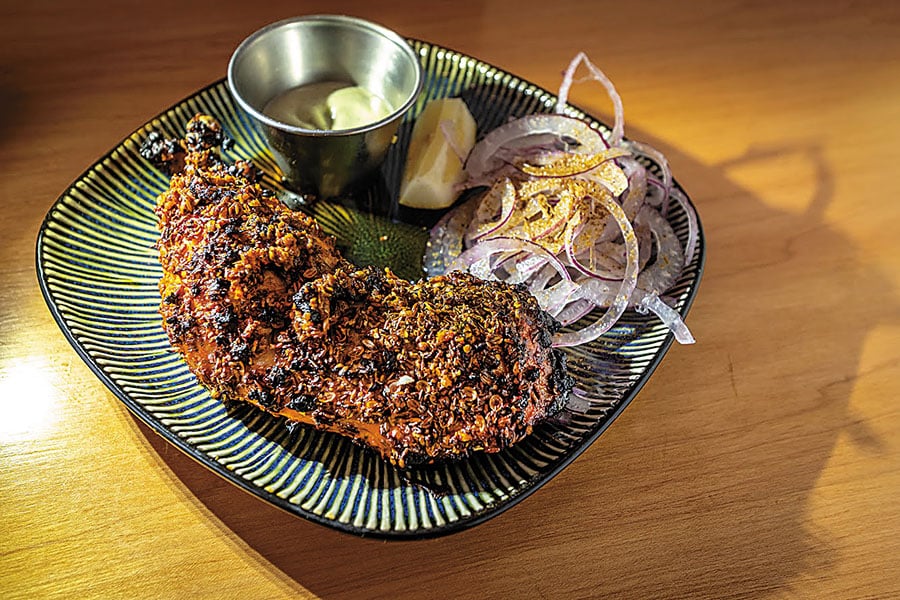The rise of regional Indian food around the world
A new slew of Indian restaurants abroad are dishing up cuisines from lesser-known regions of the country, pushing aside curry-house stereotypes


Lamb chops with tempered greens and bhapa aloo at Ritu Dalmia’s Cittamani
Coconut laddoos filled with flavours of a lime tart, khoya barfi layered with dark chocolate and a hint of orange reminiscent of that Valrhona chocolate bar, mithai with rose and lychee. These are just some goodies being offered by one of India’s largest sweets and snacks makers this festive season. Bikanervala, the 115-year-old brand that began by selling namkeen and mithai from a stall in old Delhi’s Paranthe Wali Gali in 1950 and which is now a ₹1,100-crore business, is growing a luxury offshoot.The chic inventive mithai is the brainchild of Sanjay and Renuka Aggarwal, part of the family’s third generation, who have roped in trained-in-Paris pâtissier Sahil Mehta to create these confections for their new brand Saugaat. Mehta, who had earlier consulted with French pastry outlets like La Opera in Delhi, has been studying the traditions of mithai for the last few months, as his confections are meant not just for privileged Delhi and Mumbai party goers, but for a foreign audience too. There are plans to set up studios in Milan and Paris to compete with strong dessert traditions there. “After all,” Sanjay says, “my grandfather always wanted to take our food to foreigners. Look at the popularity of international foods in India. It is time now for our traditional bites to go global and become mainstream too.”
The Aggarwals are hardly alone in their ambition. As palates get globalised and millennial diners the world over open up to newer cuisines and experiences, Indian chefs, restaurateurs and entrepreneurs are on a mission to correct stereotypes associated with our cuisines. After decades of being perceived as lowbrow, cheap, spicy “curry”, food from the country is being reinvented in what can be seen as the ‘third wave’ of Indian gastronomy internationally: Plating up flavours that are regional and more self-confident—the kind of food Indians in India eat and recognise as their own.
This third wave is different from earlier versions of Indian restaurant food that pandered to Western stereotypes and tastes: At curry houses, set up in the early 20th century by untrained cooks, and then in the 1990s, by professional chefs who sought to ‘Frenchify’ Indian food in expensive restaurants with dishes tailored to appeal to a Western palate.Pollo tandoor primavera at Cittamani
Today, both these approaches are being thrown out. Indian chefs may not have read Orientalist Edward Said, but they are finally shaking off the burdens of Orientalism and beginning to see themselves and their food independent of the Western lens. In fact, this assertion of a more self-confident Indian identity through food is not just limited to chefs. Madhur Jaffrey, cookbook author and TV host, who defined so much of the discourse around Indian food in the decades post-Independence, says about the newer lot of Indian American food writers: “My generation of Indians in the US didn’t see ourselves as brown. Now, the present generation of Indian American food writers see themselves as more conscious of their identity and heritage. Their stance is more aggressive—that ‘this is our food, we like it the way it is, and if you taste it, you will also like it’,” she says.Similarly, a slew of chefs and restaurateurs born and brought up in India are serving food they recognise as their own without attempts to customise it to foreign palates or expectations. In the US this is recognisable in restaurants both on the East and West coasts. In New York, when Indian Accent opened in 2016 at the Le Parker Meridien Hotel, it broke many stereotypes. It didn’t look the way Indian restaurants were expected to look, as Pete Wells The New York Times’ legendary food critic noted, and it didn’t serve food that seemed “conventional” or even “authentic” to an American audience. Instead, this was the smart, clever, yet rooted in regional traditions kind of food that Manish Mehrotra, Indian Accent’s corporate chef, had already built a reputation for in New Delhi.
Curry Pour at Sujan Sarkar’s Rooh
More than three years down the line, there seems to be a big leap in audience evolution. Chintan Pandya, executive chef of Adda Indian Canteen in Long Island City and Rahi in West Village, both owned by restaurateur Roni Mazumdar, is one of the most talked about younger Indian chefs in the US at the moment. Born in Mumbai and trained at the Oberoi, Pandya creates menus that incorporate dishes popularly served in homes and restaurants across India. Dishes that he calls “unapologetically Indian”, which include the likes of bheja fry and tawa kaleji.“It was beyond our wildest imagination that goat brains at Adda would be one of the biggest attractions, and people would travel across the country just to try it. Even five years ago that would not have been possible,” Pandya says, talking about how Indian food and perceptions about it are rapidly evolving in the US. The restaurant group says it is following a philosophy of demystifying Indian food for Americans, in contrast to earlier restaurants that would try to Americanise their offerings to get footfalls. Spice levels have been kept intact and there are conversations around culturally unique ingredients.
Chef Sujan Sarkar, who worked at Olive Delhi, is another leader of this movement of mainstreaming Indian food. Sarkar helms a bunch of restaurants in the US, including the very successful Baar Baar in New York and Rooh in San Francisco, Chicago and Columbus, a restaurant that serves inventive food combining local ingredients with strong regional Indian underpinnings, a la salmon and Bay shrimp paturi.
One of the biggest breakthroughs that restaurants such as these, and other trendy ones such as Dosa in San Francisco, have managed to achieve is the idea of upscale gourmet Indian food, for which diners may be ready to pay more. A few restaurants such as Srijith Gopinathan’s Michelin-starred Campton Place at the Taj in San Francisco (serving predominantly South Indian flavours with Californian ingredients) had been able to establish themselves as fine dine, but in general Indian food has remained associated with cheap takeaways.
*****
Unlike the US, the cycle of evolution in London, the most sophisticated market for Indian food internationally, given the historical connect, has reached another phase: From the cheap curry-house stereotype to expensive high-quality diners, to more casual restaurants serving regional, high-quality food that will undoubtedly facilitate mainstreaming.
Though curry houses have been on the wane for a few years now (suffering from high rents among a host of other issues), the idea of more authentic Indian food has been difficult to establish in popular imagination: This despite the fact that restaurants such as those of Camellia and Namita Panjabi (Amaya, Chutney Mary and Veeraswamy) have been serving classical Indian dishes in upscale, luxury restaurants for more than 15 years.
In 2001, Camellia Panjabi started a casual chain of street food-and-thali focussed restaurants, Masala Zone. There are now seven of these in London, but Panjabi recalls the resistance the idea of the thali faced from Londoners two decades ago. “They said you are cheating us of our protein because there was more vegetarian food in the thali. So I had to explain to them the idea of a balanced Indian meal,” she recalls. Rasam at Nadodi, a restaurant inspired by Tamil cuisineThis resistance is now fading. How far Indian food has come can be seen from the new restaurants in London in the last few years: Kanishka, focussed on food from the Northeastern states, Darjeeling Express, with food from Kolkata but also celebrating various regional cuisines by home cooks (chef-owner Asma Khan gives out her premises free to women every Sunday), Kahani (Tamil food), Gunpowder, Roti Chai and, of course, Dishoom that opened a branch in Manchester last year and has been rapidly expanding, serving up Bombay style street food to its ever growing customer base.
Rasam at Nadodi, a restaurant inspired by Tamil cuisineThis resistance is now fading. How far Indian food has come can be seen from the new restaurants in London in the last few years: Kanishka, focussed on food from the Northeastern states, Darjeeling Express, with food from Kolkata but also celebrating various regional cuisines by home cooks (chef-owner Asma Khan gives out her premises free to women every Sunday), Kahani (Tamil food), Gunpowder, Roti Chai and, of course, Dishoom that opened a branch in Manchester last year and has been rapidly expanding, serving up Bombay style street food to its ever growing customer base.
These are casual restaurants, different from the Michelin-starred restaurants by chefs like Vineet Bhatia and Atul Kochhar. Their rise is obviously important for regional Indian flavours to go mainstream. “Today’s customers are more knowledgeable and better travelled. They are aware because social media has shrunk the world and just because they are paying lower prices does not mean that they will settle for something they perceive as inauthentic,” says Sameer Taneja, chef of Kanishka and Benares.
It is not just the UK and the US where a more “authentic” (though that is an idea always ready to be challenged) regional expression of Indian food is finding more evolved audiences. In Milan, chef Ritu Dalmia’s modern Indian restaurant Cittamani and her latest casual diner Spica (where the food is inspired by her travels all over the word, including in India) are drawing surprisingly discerning audiences. “There were always people who wanted more authentic Indian food, and there are still those who associate it with tandoori stereotypes. But now, the latter know that we don’t serve stereotypes,” says Dalmia.Bhatti da Murgh at Adda by Chintan Pandya
When she served up karhi pakori, going back to her Marwari roots, at a high-profile launch of the restaurant Viva, in which she is a partner, it was lapped up by the Milanese audience, who were until now exposed only to dal makhni and red gravies, if at all.In Kaula Lumpur, Nadodi, a restaurant inspired by Tamil cuisine and all the other cuisines that Tamil food has inspired, is slated to be the next big global Indian restaurant after Gaggan. Some of its partners, including Kartik Kumar, the restaurant’s brand director, and chef Sricharan Venkatesh trained under Gaggan Anand at his Bangkok restaurant. They focus on global gastronomy themes like zero wastage, local ingredients as well as techniques like fermentation, and serve dishes like lamb chops with South Indian achar and a stunning zero wastage rasam cocktail. However, the dazzling technique and interpretations do not take away from nuanced cooking rooted in tradition. “The restaurant’s name is a reference to our nomadic status we are away from our homeland but still its influences inform us and our food,” says Kumar.
As identity gets plated up, chefs and enthusiasts are beginning to see themselves through a prism distinctly different from how others have seen India, the not-so-wounded civilisation, in the past.
First Published: Nov 16, 2019, 08:34
Subscribe Now


